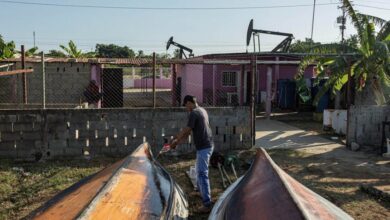We can discover the dark side of the moon!
Listen this article
The Chang'e-4 Mission departed from China and is expected to descend by the end of January. LatinAmerican Post reviews the details of this event

Humanity returns to the Moon. Since Gene Cernan did it in 1972, it had not received a known visit at least from planet Earth. But this cycle will end in 2019 when the Chang'e-4 Mission, consisting of a probe carried by the Long March-3B rocket, landed in the Von Kármán crater, located on the dark side of the Moon.
Leer en español: ¡Podremos descubrir el lado oscuro de la luna!
BBC explains that the so-called ' dark side' of the moon has not been explored by any spacecraft. That part is illuminated by the sun and the adjective of dark is attributed to that part of that cannot be seen from the planet earth. The Chang'e-4 has a descent module and an exploration vehicle that would make that visualization more feasible.
Humanity is once again taking an important step in science, or at least that is what it intends. It is expected to carry out the first ever landing on the dark side of the Moon, according to the state news agency Xinhua, and in information replicated by BBC Mundo. According to Agencia EFE, the Gran March-3B rocket took off this Friday from the Xichang Satellite Launch Center in Sichuan province.
Maybe you're interested in reading: 7 curious facts about the moon that will surprise you
Is the moon farther than it was 40 years ago?
The mission departed from the Xichang satellite launch center. BBC explains the Von Kármán crater is interesting to scientists because they are located in a larger and older impact zone on the lunar surface, called Aitken.
The most respected theory in this regard points to the formation of that area due to the impact of a giant asteroid billions of years ago, and that, in turn, originated synchronous rotation that rotates on its own axis with the same duration that around the earth.
BBC continues and explains that the far side of the Moon has a thicker crust and many more craters than its more familiar face. The Chang'e-4 mission aims to open the way for the shipment of rock samples from that lunar region to Earth.
The exploration vehicle plans to survey the geology of the region and the composition of its soil. Another part of the theory indicates that the aforementioned impact could cross the crust to the lunar mantle, so they believe that the instruments of Chang'e-4 could determine the truth of this belief, concluded the prestigious British media.
#Infografía #ChangE4 de China será la primera nave espacial en la historia en aterrizar en la cara oculta de la Luna. La misión realizará pruebas de crecimiento de plantas y escuchará emisiones de radio normalmente bloqueadas por la atmósfera terrestre.
Vía Graphic News pic.twitter.com/AYWf19zfAH
— La Jornada (@lajornadaonline) 4 de diciembre de 2018
Expert opinion
Argentina's Clarin recalled the probe's take-off, the statements of Liu Hanlong, director of the experiment and vice president of Chongqing University (located in central China), to the state news agency Xinhua. " We want to study the respiration of seeds and photosynthesis on the Moon."
In turn, Xie Gengxin, chief designer of the experiment, said: "We have to maintain the temperature in the mini biosphere in a range between 1 and 30 degrees, and control humidity and nutrition appropriately. natural light from the surface of the Moon IGNORE INTO the container to make the plants grow, "replied the same medium.
Speaking of the most precise characteristics of the Chang'e-4, it is a vehicle similar to the Yutu, which was launched in 2013 aboard the Chang E 3, the first Chinese lunar explorer, and currently runs the visible side of the Moon .
Chronicle of Mexico reported that Wu Weiren, head of the Chinese lunar exploration program, explained in the presentation of the mission, that the new lunar explorer differs from the Yutu in its greater adaptability to complicated terrain. He also stressed that "it is the lightest in the world of its kind, weighing only 140 kilos, much less than that of its predecessors."
Finally, the BBC recalls that in 2013 when he interviewed the Chinese researcher Ouyang Ziyuan, from the department of lunar exploration and deep space, about the sending of the Chang'e-3 mission, the latter advanced the benefits that the moon can give to The humanity.
"It is full of resources, mainly rare minerals, titanium, uranium, which are very scarce on Earth, and these resources could be used without limitations, there are many possible developments, it is beautiful, so we hope to use the Moon to support the development sustainable of the humans and the society ", ensured textually at that time.
LatinAmerican Post | Onofre Zambrano
Translated from: '¡Podremos descubrir el lado oscuro de la luna!'





